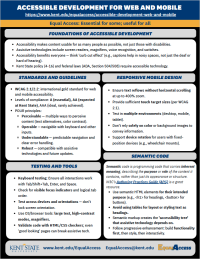Upcoming Sessions
ACCESSIBLE DEVELOPMENT FOR WEB AND MOBILE
Ensure that your code is compatible with all assistive technology and types of disabilities.
Dec. 2, 2025; 1:30 p.m. - 3:00 p.m.
Apr. 21, 2026; 10:30 a.m. - noon
Downloadable and Accessible One-Pager Fact Sheets (PDF)
Accessible Development for Web and Mobile (PDF)


Accessible Development for Web and Mobile
Writing accessible code is an essential development skill and a necessity for users accessing your digital content or application via many different devices, interfaces, and assistive technologies. Accessible code is easier to write, easier to understand, and enables the greatest amount of access to the information that you care about.
What is accessible code?
Accessible or semantic code is code that utilizes elements for their intended purpose, such as using a heading <h> tag for a heading instead of a regular paragraph text <p> tag with styling applied to it. Using semantic HTML markup and writing code to be accessible not only makes development easier, but it provides a number of important benefits to your users, especially those that use assistive technology.
Why is accessible code important?
Writing accessible or semantic code provides a number of benefits to developers and users alike, such as:
- Making code easier to understand and develop with
- Ensuring that code is more responsive and adaptable to a wide variety of devices and technologies
- Improving SEO as well as accessibility
Assistive technology users in particular - such as screen reader users - benefit greatly from accessible code, which allows them to more easily understand and navigate the content on a web page or application.
Campus Partners
Digital Accessibility Team
Support for testing and editing technology and content for better accessibility.
Email: equalaccess@kent.edu
Web: /digitalaccessibility
Doug Flower, Digital Accessibility Specialist
Email: dflower7@kent.edu
